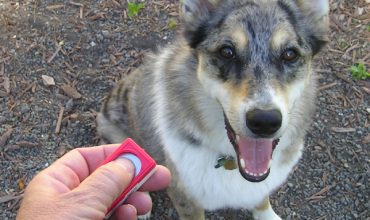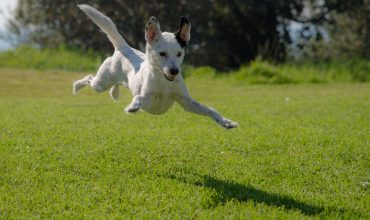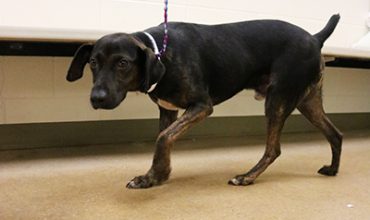On Surfaces Place treats on a table, coffee table, or counter where you are close enough to cover them up or remove them if needed. You can place them on a plate to imitate real life. When your dog shows interest tell him “Leave it.” If he looks away, click or use your marker word and reward him. If he goes for the food or jumps on the counter, immediately cover the food up and take the dog away. When he stops trying to get at it, mark and reward. Your reward should come from your pocket or somewhere else
Read More
Archives for Puppy or dog
Clicker Training Basics
Clicker training means using a sound (a click) to communicate with your dog. Clickers have been in use for more than forty years. The method is best known from the world of marine animal training where people need a way to communicate with animals like dolphins and orcas that can’t be controlled by physically forcing them to do things. How does it work? It is fabulously simple. First we teach the dog that the click means he has won a treat. Then we use the click to tell the dog when he has done something we like. Essentially: When your
Read More
Anti-Jumping
Why Dogs Jump Dogs jump up to say hello, quite simply. They don’t know how humans prefer to be greeted, and it never occurs to them that they might knock us over or ruin our clothes. Thankfully, consistent anti-jump training can quickly solve the problem for good. For this exercise, you’ll act as an on/off switch. When the dog is four feet on the floor, you’ll be “on” (verbal praise, petting, bending down to greet the dog, etc.). While the dog is jumping, you’ll be “off”(stand up, completely disengaged, no verbal attention, even in the form of “NO!”, turning your
Read More
Afraid of the stairs? Or of getting into/out of the car?
Note: These exercises can be adapted to entering and exiting cars and other motor vehicles. Is your dog afraid of steps and stairways? Perhaps past experiences led the dog to associate steps with something unpleasant, frightening and/or hurtful. Perhaps the dog was yelled at for going up or down a stairway, or had fallen down stairs during his formative weeks, or was pushed down the stairs. Maybe the dog has never encountered stairs before. Some people respond to such fears by forcing the dog up and down the stairs. But this approach doesn’t always provide the dog with an opportunity
Read More
Essential Dog Toys & How to Use Them
The things that are usually the most attractive to dogs are often the very things that are the most dangerous.
Read More
Keeping your High Energy Dog Happy & Healthy
Congratulations on adopting your new family member! Your new dog is a dog that will need some additional time and thought put into their daily exercise and training routine due to his/her energy level. Below are some ways that can both keep your dog happy and healthy and help you to avoid behavioral problems that can arise from lack of mental and physical stimulation in high energy and working dogs. Feeding Meals Turning meal time into work time is a great way to give your dog a job to do and keep him well behaved and mentally fulfilled. So toss
Read More
Submissive and Excitement Urination
Submissive Urination Submissive urination occurs when a dog feels threatened. It may occur when he’s being punished or verbally scolded, or when he’s approached by someone he perceives to be threatening to him. It’s important to remember that this response is based on the dog’s perception of a threat, not the person’s actual intention. Submissive urination may resolve as your dog gains confidence. You can help to build his confidence by teaching him commands and rewarding him for obeying. You should also gradually expose him to new people and new situations and try to make sure all of his new
Read More
Separation Anxiety
Treatment for Mild Separation Anxiety If your dog has a mild case of separation anxiety, counterconditioning might reduce or resolve the problem. Counterconditioning is a treatment process that changes an animal’s fearful, anxious or aggressive reaction to a pleasant relaxing one. It’s done by associating the sight or presence of a feared or disliked person, animal, place, object or situation with something really good, something the dog loves. Over time the dog learns that whatever he fears actually predicts good things for him. For dogs with separation anxiety, counterconditioning focuses on developing an association between being alone and good things
Read More
Helping Your Dog Overcome The Fear of Thunder And Other Startling Noises
It’s not uncommon for dogs to be frightened of thunder, firecrackers or other loud sounds. These types of fears may develop even though your dog has had no traumatic experiences associated with the sound. Many fear-related problems can be successfully resolved. However, if left untreated, your dog’s fearful behavior will probably get worse. The most common behavior problems associated with fear of loud noises are destruction and escaping. When your dog becomes frightened, she tries to reduce her fear. She may try to escape to a place where the sounds of thunder or firecrackers are less intense. If, by leaving
Read More
The Fearful Dog
This dog is a dog who has been fearful while in shelter and has taken longer than most to adjust to new situations. This dog should be given a significant amount of time to decompress and adjust once in the adopters home before adopters attempt to bring the dog new places or introduce new people or animals. Understanding and responding to the dogs’ body language will be very important in helping this dog adjust comfortably to his/her new home. Dogs who are fearful may attempt to communicate and/or show their fears in a variety of ways including; panting, pacing, growling,
Read More













